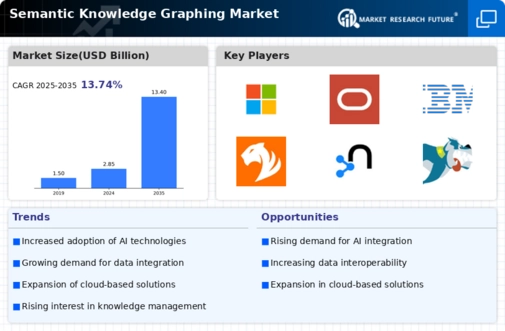Growing Emphasis on Personalization
The growing emphasis on personalization in customer experiences is driving the Semantic Knowledge Graphing Market. Companies are increasingly leveraging semantic knowledge graphs to tailor their offerings based on individual customer preferences and behaviors. By mapping relationships between various data points, organizations can create more personalized interactions, which are essential for enhancing customer satisfaction and loyalty. The personalization market is expected to reach USD 1.5 trillion by 2025, indicating a substantial opportunity for businesses that effectively utilize knowledge graphs. This trend suggests that as companies strive to differentiate themselves in competitive markets, the demand for semantic knowledge graphs will likely increase, as they provide the necessary insights to deliver customized experiences.
Rising Demand for Data-Driven Insights
The increasing reliance on data-driven decision-making across various sectors appears to be a primary driver for the Semantic Knowledge Graphing Market. Organizations are seeking advanced analytical tools to extract meaningful insights from vast datasets. This trend is evidenced by a projected growth rate of approximately 25% in the adoption of knowledge graph technologies over the next five years. As businesses strive to enhance operational efficiency and customer engagement, the demand for semantic knowledge graphs, which facilitate better data interpretation and relationship mapping, is likely to surge. Consequently, this growing need for actionable insights is propelling the Semantic Knowledge Graphing Market forward, as companies invest in technologies that can transform raw data into strategic advantages.
Need for Enhanced Data Interoperability
The necessity for enhanced data interoperability among disparate systems is a critical driver for the Semantic Knowledge Graphing Market. Organizations are often challenged by data silos that hinder effective communication and collaboration. Semantic knowledge graphs offer a solution by enabling seamless integration of data from various sources, thereby facilitating a unified view of information. This capability is particularly vital in sectors such as healthcare and finance, where data integration can lead to improved outcomes. The market for data integration solutions is projected to grow at a CAGR of 20% through 2026, underscoring the increasing recognition of the importance of interoperability. As businesses prioritize data connectivity, the Semantic Knowledge Graphing Market is poised to benefit from this trend.
Regulatory Compliance and Data Governance
The growing focus on regulatory compliance and data governance is emerging as a significant driver for the Semantic Knowledge Graphing Market. Organizations are under increasing pressure to manage data responsibly and adhere to various regulations, such as GDPR and CCPA. Semantic knowledge graphs can assist in ensuring compliance by providing a clear structure for data management and lineage tracking. The market for data governance solutions is projected to grow at a CAGR of 18% through 2025, reflecting the heightened awareness of data stewardship. This trend indicates that as organizations prioritize compliance and governance, the Semantic Knowledge Graphing Market will likely see increased adoption of knowledge graph technologies to facilitate these objectives.
Advancements in Natural Language Processing
Recent advancements in Natural Language Processing (NLP) technologies are significantly influencing the Semantic Knowledge Graphing Market. NLP enables machines to understand and interpret human language, which is crucial for the effective utilization of knowledge graphs. As organizations increasingly adopt NLP solutions to enhance customer interactions and automate processes, the integration of semantic knowledge graphs becomes essential. The market for NLP is expected to reach USD 43 billion by 2025, indicating a robust growth trajectory. This growth suggests that as NLP capabilities improve, the demand for semantic knowledge graphs will likely increase, as they provide the necessary framework for organizing and contextualizing information derived from natural language data.

















Leave a Comment